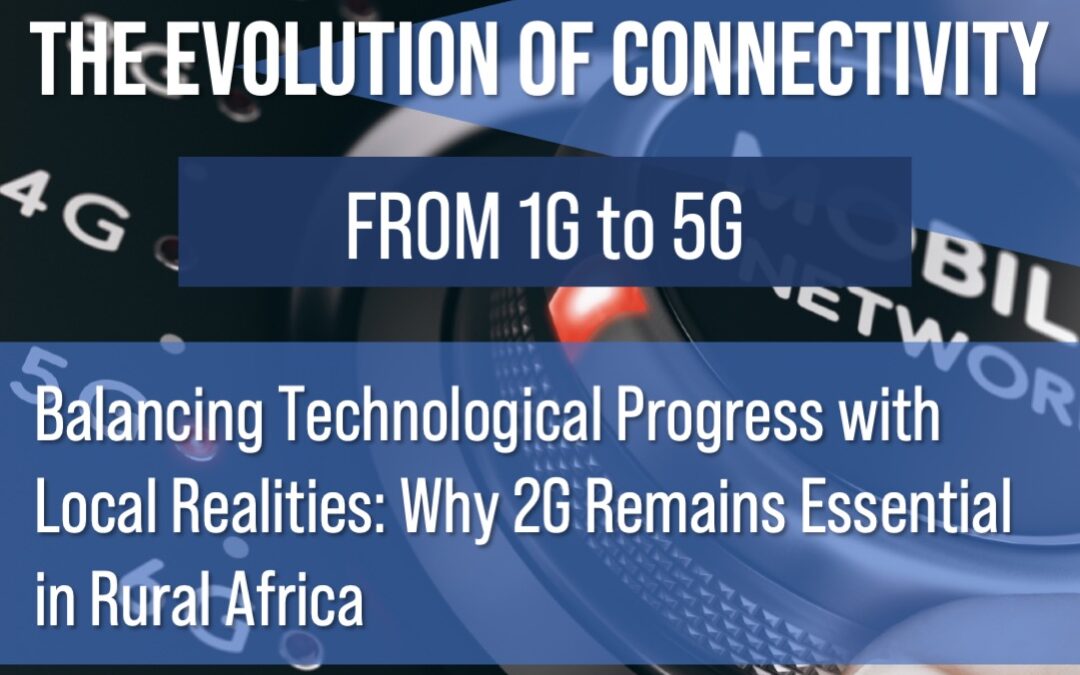Since the advent of mobile telecommunications, technologies have evolved significantly, progressing from 1G to 5G, with each generation bringing notable changes in available services, quality of experience, latency, and capacity. It all started with traditional circuit-switched voice services but gradually moved to packet-switched data services that now offer voice, video, and even support the Internet of Things (IoT). While some regions of the world quickly adopt the latest technologies, others, particularly rural areas in Africa, continue to rely heavily on 2G. This article explores the evolution of mobile networks, the current state of connectivity, and examines why 2G remains relevant and vital in many parts of the world, especially for education, literacy, and IoT development.
The history of mobile networks begins with 1G, launched in the 1980s, allowing the first analog voice communications. The technology was primitive, limited to voice, with bulky and expensive devices. The introduction of 2G in the 1990s marked a revolution with the advent of digital communications and short messaging services. This generation allowed features like SMS and email on phones equipped with SIM cards, making communications more accessible and convenient. Around this time, the Internet was seeing tremendous growth, connecting computers, organizations, and people across the world. It became evident that there was a need to deliver better data services from mobile devices and interconnect them to packet data networks, namely the Internet.
3G, introduced in the 2000s, enabled the era of mobile internet, offering higher data speeds that made streaming and web browsing possible. We moved from narrowband to wideband technologies to improve the achievable throughputs and capacity of our mobile networks. This evolution transformed mobile phones into multifunctional tools for information, entertainment, and education. With higher data speeds, mobile phones became gateways to vast educational resources, contributing to the growth of digital literacy. The launch of 4G around 2010 pushed these capabilities even further, enabling demanding applications like online gaming, high-definition video streaming, and more advanced educational tools while reducing latency and increasing data transmission speeds. This evolution has been crucial in making mobile technology a fundamental part of learning and access to information.
5G represents the most recent evolution, promising extremely high data speeds, large connection volumes, and ultra-low latency. It enables massive connectivity for millions of devices, paving the way for innovations like autonomous vehicles, telemedicine, smart cities, and advanced IoT applications. In education, 5G has the potential to revolutionize remote learning and bring advanced digital tools to classrooms globally. Additionally, it facilitates the development of critical applications requiring real-time communication and extreme reliability, such as remote surgeries, contributing to educational advancements in medicine and technology.
The persistence of 2G in rural areas of Africa is not merely a matter of technological lag but rather a pragmatic response to local realities and specific needs. The existing infrastructure for 2G is widely deployed and well-established, making it much less costly to maintain and operate than newer networks. For operators and users, it is economically advantageous to continue using 2G, especially in regions where incomes are limited. Phones compatible with 2G are generally more affordable and durable than newer smartphones. In regions where purchasing power is limited, these accessible devices allow a larger portion of the population to access basic telecommunication services. Moreover, these phones often have longer battery life, which is crucial in areas where access to electricity is limited.
For many users in these regions, communication needs are primarily limited to voice calls and SMS, services that 2G provides reliably. Advanced features offered by 3G or 4G, such as video streaming or social media, are not always a priority for these populations. Moreover, 2G technology plays a crucial role in basic education and literacy programs. In areas where schools and educational resources are scarce, SMS-based learning programs have been developed, allowing students to receive lessons and quizzes via text messages, making education more accessible. 2G networks are also integral to the deployment of IoT solutions that support agriculture, health, and education in rural areas. These networks enable simple IoT devices that can monitor environmental conditions, support remote health diagnostics, and provide educational content through basic connectivity, all of which are essential for development in these regions.
2G presents an interesting paradox in the modern telecommunications world. On one hand, it is seen as an outdated technology, unable to provide the advanced services required by an increasingly connected society. On the other hand, it continues to play a crucial role in regions where needs and economic realities dictate simple and reliable solutions. The resilience of 2G in the event of natural disasters or prolonged power outages also makes it an indispensable technology for emergency communications and situations where modern infrastructures fail.
The future of connectivity in Africa will largely depend on overcoming challenges such as the high cost of infrastructure, low population density in rural areas, and lack of digital education. However, the continued relevance of 2G highlights the importance of delivering the right connectivity to rural areas and helping their communication habits grow. Any connectivity is better than no connectivity, and this should be the starting point to build a better and more integrated society.
The evolution of mobile networks, from 1G to 5G, has transformed how we communicate and interact with technology and each other. However, while 2G is seen as a technology of the past in urbanized and technologically advanced regions, it remains a cornerstone of telecommunications in many parts of the world. As such, it embodies an essential and sustainable connectivity solution, particularly suited to the realities of rural areas in Africa. As we continue to advance toward faster and more integrated connectivity, it is crucial not to forget the importance of providing access to basic technologies for all, ensuring that no one is left behind.
https://electronics360.globalspec.com/article/10637/the-evolution-of-mobile-from-1g-to-5g
https://forum.videotron.com/t5/blog/from-1g-to-5g-a-brief-history-of-mobile-networks/ba-p/43211





